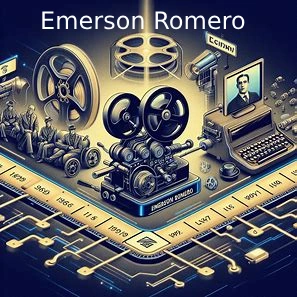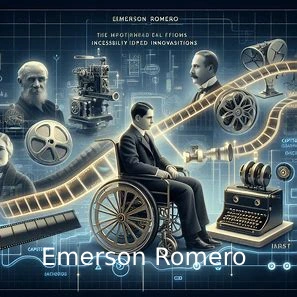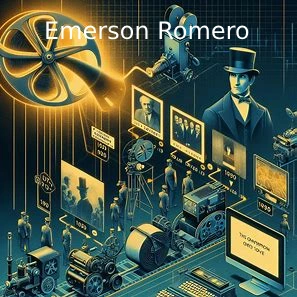Emerson Romero, born in Havana, Cuba, in 1900, is celebrated as a trailblazing figure in both the film industry and the Deaf community. Though his acting career was cut short by the advent of sound films, Romero turned adversity into innovation, becoming a pioneer in accessibility advocacy.
His life’s work not only transformed how films were made but also emphasized the importance of inclusivity for individuals with disabilities.
This article explores Romero’s life, his contributions to captioning, and his enduring influence on modern media accessibility.
Early Life and Silent Film Career
Romero was born into a middle-class Cuban family and grew up during an era when silent films dominated entertainment. His brother, a filmmaker, inspired him to enter the film industry. In the 1920s, Romero moved to Hollywood, where he adopted the stage name Tommy Albert to appeal to American audiences. His athletic ability and charm earned him roles in more than 20 silent films, including:
- Beachnuts
- The Cat’s Meow
- Great Guns
The Appeal of Silent Films
Silent films provided a universal platform for storytelling, relying on expressive acting and text intertitles. This format allowed Romero, who was deaf, to thrive. Audiences appreciated his physicality and comedic timing, making him a sought-after actor during the silent film era.
However, the rise of “talkies” in 1927 changed everything.
The Turning Point: The Advent of Talkies
Challenges for Deaf Actors
When sound films emerged, the industry shifted away from silent storytelling. Dialogue became central, and studios removed text intertitles, which were vital for deaf actors and audiences. Romero, like many others, faced immediate exclusion. Studios preferred actors with clear speech and removed subtitles altogether, alienating the Deaf community.
Romero’s Resilience
Rather than give up, Romero returned to New York, where he focused on improving accessibility for deaf individuals. He joined the Deaf community’s advocacy efforts, working as an editor for the Digest of the Deaf magazine and collaborating with the Theatre Guild of the Deaf, a group dedicated to producing accessible plays.

Romero’s Pioneering Work in Captioning
Innovating Captioning Techniques
In the 1940s, Romero began experimenting with ways to make films accessible. Using basic tools, he developed a method to insert text captions directly into film strips. Although his technique was rudimentary, it was revolutionary for its time. Romero would splice frames of film, adding captions between scenes to provide dialogue and narrative context.
Key Features of His Work:
- Handwritten or typewritten captions added manually to film strips.
- Films were distributed to schools and community groups for the Deaf.
- The process required meticulous labor, but it demonstrated the potential for widespread accessibility.
Collaboration and Expansion
Romero’s work caught the attention of prominent educators, such as Edmund Boatner and J. Pierre Rakow, at the American School for the Deaf. They adopted and refined his techniques, leading to the establishment of Captioned Films for the Deaf in 1949. This federally funded program made captioned films available nationwide, ensuring that deaf audiences could enjoy mainstream movies.
Advocacy Beyond Film
Designing Accessible Tools
Romero extended his advocacy to inventing practical tools for everyday use by deaf individuals. Some of his notable inventions included:
- The Vibralarm: A vibrating alarm clock that ensured deaf individuals could wake up on time.
- Doorbell Signalers: Devices that alerted deaf users to visitors through visual or tactile signals.
- Smoke Detectors and Baby Alarms: Early designs that used light or vibration to ensure safety in homes with deaf residents.
Community Leadership
Romero also served as a leader within the Deaf community. He wrote extensively about accessibility issues, offering advice and solutions to common challenges faced by deaf individuals. His weekly columns in local newspapers provided insights into both his personal experiences and broader advocacy efforts.
Legacy of Emerson Romero
Influence on Modern Media
Romero’s early captioning methods laid the groundwork for modern closed-captioning systems. His innovations inspired technological advancements that became industry standards, including:
- Open captioning in the 1950s and 1960s.
- Federal mandates for closed captioning in television broadcasting.
- Integration of accessibility features in streaming platforms like Netflix and YouTube.
Recognition and Celebrations
Romero’s contributions are honored annually during Hispanic Heritage Month and other cultural events. Google even celebrated him with a Doodle, highlighting his dual identity as a Cuban-American actor and accessibility advocate
Why Emerson Romero’s Story Matters Today
Romero’s life underscores the importance of resilience and innovation in the face of discrimination. His work continues to inspire efforts to make media, technology, and public spaces more inclusive. In today’s era of digital accessibility, his pioneering spirit serves as a reminder that inclusivity benefits everyone.

FAQs About Emerson Romero
1. What is Emerson Romero best known for?
Romero is best known for his contributions to accessibility, particularly his early innovations in captioning sound films for the Deaf community.
2. Why did Emerson Romero leave Hollywood?
The advent of sound films excluded deaf actors, forcing Romero to leave Hollywood and focus on accessibility advocacy.
3. What were Romero’s key inventions?
Romero invented tools like vibrating alarm clocks, doorbell signalers, and smoke detectors to improve daily life for deaf individuals.
4. What is the Captioned Films for the Deaf program?
Established in 1949, this program provided captioned films to deaf audiences across the United States, inspired by Romero’s early efforts.
5. How is Romero’s legacy celebrated today?
Romero’s contributions are recognized during Hispanic Heritage Month and in discussions about media accessibility and disability rights.
Final Words
Emerson Romero was more than a silent film star; he was a visionary who used his platform to advocate for equality and accessibility. His story reminds us that innovation often arises from adversity and that inclusivity is essential in creating a better society. Romero’s legacy lives on, not only in the films he acted in but also in the lives of the countless individuals who benefit from the accessibility features he helped pioneer.




